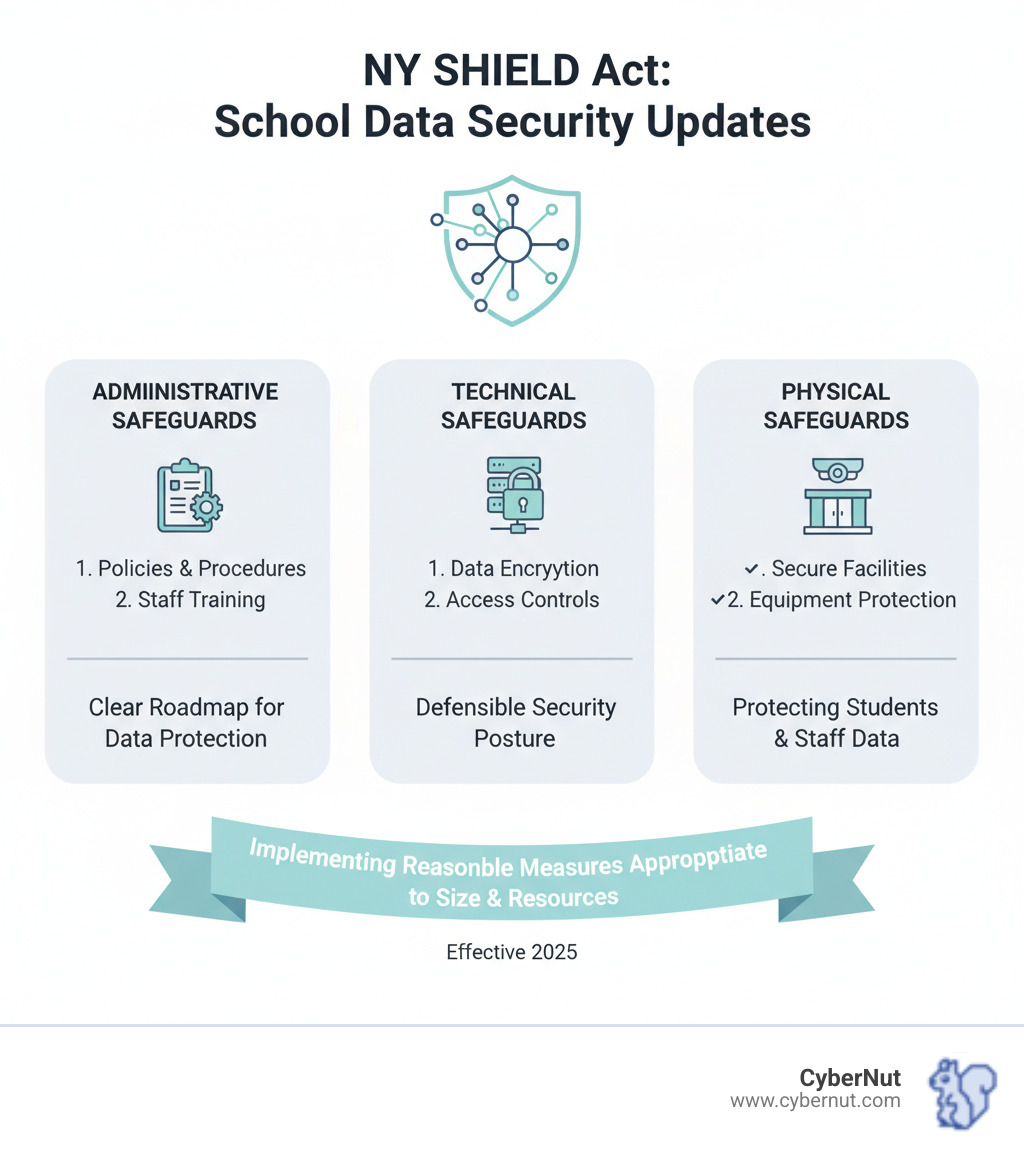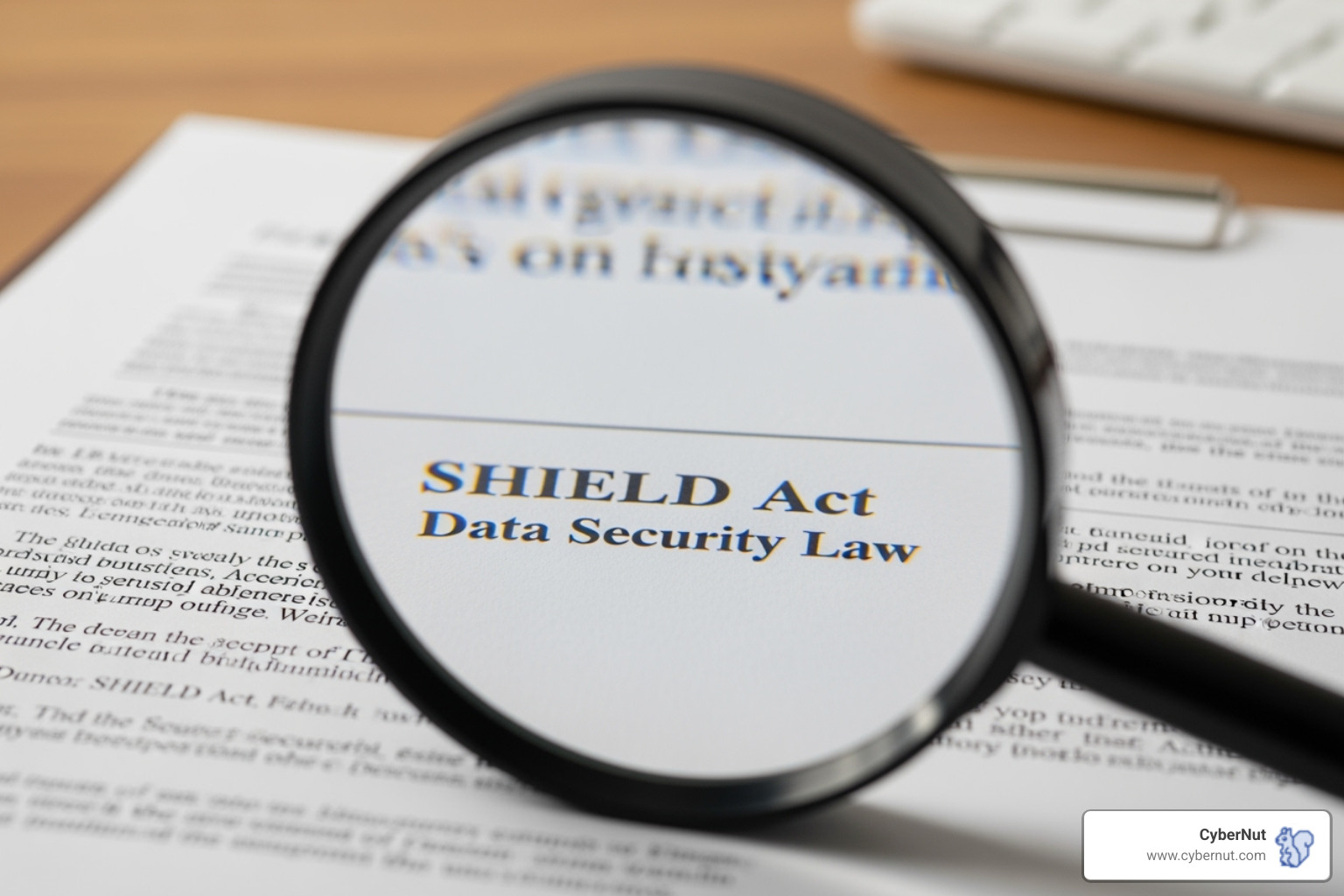
Oliver Page
Case study
October 1, 2025

All About New York's Stop Hacks and Improve Electronic Data Security (SHIELD) Updates for Schools can be summarized in these key points:
For K-12 IT directors, New York's SHIELD Act is a fundamental shift in data protection, not just another compliance checkbox. Fully enforceable since March 2020, the law dramatically expands data breach requirements and applies to any school handling New York residents' data, regardless of the school's location.
This means your district must protect everything from student health records and biometric lunch payment data to staff payroll information and login credentials. The shift to remote learning has amplified these risks, expanding the attack surface with staff working from home and students using personal devices—a reality the SHIELD Act directly addresses.
The good news is that the law provides a clear roadmap. By implementing reasonable administrative, technical, and physical safeguards appropriate to your school's size and resources, you can build a defensible security posture while protecting the students and staff who trust you with their data.
Ready to assess where your district stands? Get a free phishing audit to identify your vulnerabilities before they become violations.

Related content about All About New York’s Stop Hacks and Improve Electronic Data Security (SHIELD) Updates for Schools:
School administrators must understand a critical point: if your school handles data from even one New York resident, the SHIELD Act applies to you, no matter your location. Enforceable since March 2020, this law fundamentally changed how schools must protect private information.
Schools are prime targets for cybercriminals because they handle valuable data, from student health records and staff Social Security numbers to payment information and login credentials. The SHIELD Act's message is clear: if you possess private information of New York residents, you are responsible for protecting it. This is about honoring the trust that students, parents, and staff place in schools every day. For a comprehensive look at how this law impacts your cybersecurity strategy, check out our guide on what to know about the NY SHIELD Act and its impact on school cybersecurity.

The SHIELD Act gets serious by dramatically expanding what counts as "private information" and what qualifies as a "data breach." These definitions directly determine what you must protect and when you must report an incident.
Private information now includes:
This expansion means a student's Google Classroom password or a staff member's direct deposit information are legally protected private information.
The definition of a data breach was also broadened from data acquisition to include unauthorized access to computerized data. This means an incident where a staff member accidentally views sensitive files they aren't authorized to see could constitute a breach, even if no data was downloaded or stolen. Your incident response plan must account for all forms of data security incidents, not just theft. For the precise legal language, you can review the official SHIELD Act text.
Many school leaders ask, "Don't we already comply with FERPA and Education Law §2-d?" The short answer is no, but understanding how these laws work together simplifies compliance.
All About New York's Stop Hacks and Improve Electronic Data Security (SHIELD) Updates for Schools has a broader scope than both. While FERPA and §2-d focus on student and teacher data, the SHIELD Act covers the private information of any New York resident, including all school staff, parents, and volunteers. Its definition of private information is also more extensive.
The good news is that these laws overlap. Complying with the NIST Framework for §2-d helps meet SHIELD's "reasonable safeguards" requirement. However, you cannot rely solely on FERPA or §2-d compliance. The SHIELD Act has unique definitions, notification timelines, and procedures that demand separate attention.
Think of it as layers of protection: FERPA is the base, §2-d adds New York-specific rules, and the SHIELD Act wraps around everything to provide comprehensive coverage.
Need help understanding where your district stands across all these compliance requirements? Get a free phishing audit to identify your vulnerabilities before they become violations.
The SHIELD Act requires schools to implement "reasonable administrative, technical, and physical safeguards" to protect private information. The term "reasonable" is intentional, allowing safeguards to be scaled to the size and complexity of your school, the nature of your activities, and the sensitivity of the information you handle. This scalability is good news for schools on tight budgets.
What the law demands is a proactive security posture, moving beyond a passive approach to building genuine resilience. The framework is built on three interconnected pillars, each addressing a different dimension of data security.

Administrative safeguards are the human side of cybersecurity, focusing on policies, training, and processes. Key requirements include:
Technical safeguards are the technology tools that work 24/7 to keep your digital assets secure. Your program should include:
For more on building a proactive security approach, see our guide on proactive cybersecurity for schools.
Physical security is the foundation that supports your digital defenses. Essential physical safeguards include:
Even with strong defenses, breaches can happen. The SHIELD Act establishes strict requirements for how schools must respond and outlines serious penalties for non-compliance. Understanding these rules is critical for protecting your students, families, and your school's reputation. The consequences of mishandling a breach can include lasting damage to community trust. For broader context, see our cybersecurity insights for New York school districts.

When a data breach occurs, time is of the essence. The SHIELD Act requires notification to be made "without unreasonable delay" and within a maximum of 30 days from the moment a breach is finded or reasonably should have been finded.
Notification must be sent to several parties:
If the breach affects more than 5,000 New Yorkers, you must also notify consumer reporting agencies (e.g., Equifax, Experian).
The notice must describe the breach, the types of information compromised, and steps individuals can take to protect themselves. Critically, if an email address and password were breached, you cannot use that email account to send the notification, as the account itself may be compromised.
Your incident response plan must detail these procedures so you can act immediately. Scrambling during a crisis is a recipe for costly mistakes. If you're concerned about your school's readiness, get a comprehensive phishing audit to identify vulnerabilities. Consumers can file a complaint with the NY AG if they believe they've been affected by a breach.
The New York Attorney General's office actively enforces the SHIELD Act, and the penalties are severe.
Real-world cases show these are not empty threats. While the following are healthcare providers, the lessons for schools are clear:
These cases, detailed in NYAG's findings on recent settlements, prove that proactive security is always cheaper than reactive penalties. Investing in safeguards and training protects your school from financial and reputational devastation.
Navigating new legislation always brings up questions. Let's tackle some of the most common concerns schools have about All About New York's Stop Hacks and Improve Electronic Data Security (SHIELD) Updates for Schools.
The SHIELD Act offers very limited exemptions. There is a scaled approach for small businesses (fewer than 50 employees, <$3M revenue, or <$5M assets), but this only means safeguards can be proportional to size—it doesn't eliminate the requirement. Most school districts exceed these thresholds anyway.
There is also a "compliant entity" exemption. If your school is already fully compliant with certain data security laws like HIPAA or the NYDFS Cybersecurity Regulation, you may satisfy SHIELD's security requirements for the specific data covered by those laws. However, the SHIELD Act's definition of 'private information' is broader (including staff data and login credentials not covered by HIPAA), so this exemption rarely provides a free pass. A gap analysis is essential to identify where you still have obligations.
Remote and hybrid learning permanently changed the cybersecurity landscape by massively expanding the attack surface. The SHIELD Act's protections follow your data wherever it goes, making robust safeguards for remote work essential.
Key requirements for a distributed environment include:
The average school district uses dozens of EdTech vendors, and the SHIELD Act holds you accountable for their security practices. Your school is typically the legal owner of student and staff data, creating a shared responsibility with your vendors.
Proactively managing this risk involves four key steps:
For more guidance, see our articles on securing data with third-party vendors and essential contract clauses for EdTech agreements. To identify potential weak points, consider getting a free phishing audit.
The key takeaway from All About New York's Stop Hacks and Improve Electronic Data Security (SHIELD) Updates for Schools is that this law is more than a compliance checklist. It's a roadmap for protecting your students, staff, and the families who trust you with their most sensitive information. The stakes are too high to treat cybersecurity as an IT-only concern.
This requires a cultural shift from being reactive to proactive. Instead of waiting for an incident, a resilient school anticipates risks, assesses vulnerabilities, and continuously strengthens its defenses. However, even the best technology can't stop breaches caused by human error. Phishing emails and weak passwords remain the top threats, which is why continuous training is absolutely essential.
When you empower every staff member and student to be a part of your defense system, you build true resilience. This is about making cybersecurity training accessible, engaging, and effective. At CyberNut, we know K-12 schools face unique challenges like limited budgets and overstretched teams. Our automated, gamified micro-trainings are designed to be low-touch and high-impact, fitting seamlessly into the school day without adding to your workload.
Cyber threats are not going away, but with the right preparation and mindset, your school can build the resilience needed to keep your community safe.
Ready to see where your vulnerabilities lie? Understanding your current security posture is the critical first step. Get a comprehensive Phishing Audit for your district to identify exactly where your risks are before they turn into breaches.
From there, you can continue building your school's defenses with ongoing training and resources designed specifically for the challenges you face. Explore CyberNut's resources to strengthen your school's defenses and take control of your cybersecurity future.

Oliver Page

Some more Insigths


Back